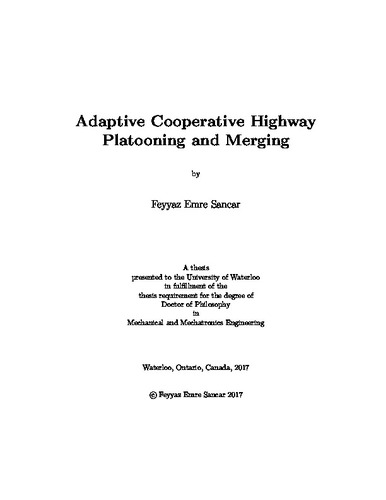| dc.contributor.author | Sancar, Feyyaz Emre | |
| dc.date.accessioned | 2017-05-19 17:20:16 (GMT) | |
| dc.date.available | 2017-05-19 17:20:16 (GMT) | |
| dc.date.issued | 2017-05-19 | |
| dc.date.submitted | 2017-05-10 | |
| dc.identifier.uri | http://hdl.handle.net/10012/11934 | |
| dc.description.abstract | As low-cost reliable sensors are introduced to market, research efforts in autonomous driving are increasing. Traffic congestion is a major problem for nearly all metropolis'. Assistive driving technologies like cruise control and adaptive cruise control are widely available today. While these control systems ease the task of driving, the driver still needs to be fully alert at all times. While these existing structures are helpful in alleviating the stress of driving to a certain extent, they are not enough to improve traffic flow. Two main causes of congestion are slow response of drivers to their surroundings, and situations like highway ramp merges or lane closures. This thesis will address both of these issues.
A modified version of the widely available adaptive cruise control systems, known as cooperative adaptive cruise control, can work at all speeds with additional wireless communication that improves stability of the controller. These structures can tolerate much smaller desired spacing and can safely work in stop and go traffic. This thesis proposes a new control structure that combines conventional cooperative adaptive cruise control with rear end collision check. This approach is capable of avoiding rear end collisions with the following car, as long as it can still maintain the safe distance with the preceding vehicle. This control structure is mainly intended for use with partially automated highways, where there is a risk of being rear-ended while following a car with adaptive cruise control. Simulation results also shows that use of bidirectional cooperative adaptive cruise control also helps to strengthen the string stability of the platoon. Two different control structures are used to accomplish this task: MPC and PD based switching controller.
Model predictive control (MPC) structure works well for the purpose of bidirectional platoon control. This control structure can adapt to the changes in the plant with the use of a parameter estimator. Constraints are set to make sure that the controller outputs are always within the boundaries of the plant. Also these constraints assures that a certain gap will always be kept with the preceding vehicle. PD based switching controller offers an alternative to the MPC structure. Main advantage of this control structure is that it is designed to be robust to certain level of sensor noise. Both these control structures gave good simulation results.
The thesis makes use of the control structures developed in the earlier chapters to continue developing structures to alleviate traffic congestions. Two merging schemes are proposed to find a solution to un-signaled merging and lane closures. First problem deals with situations where necessary levels of communication is not present to inform surrounding drivers of merging intention. Second structure proposes a merging protocol for cases where two platoons are approaching a lane closure. This structure makes use of the modified cooperative adaptive cruise control structures proposed earlier in the thesis. | en |
| dc.language.iso | en | en |
| dc.publisher | University of Waterloo | en |
| dc.subject | Platoon Merging | en |
| dc.subject | Autonomous Highways | en |
| dc.subject | CACC | en |
| dc.subject | Platooning | en |
| dc.subject | Adaptive Control | en |
| dc.subject | Collaborative Driving | en |
| dc.title | Adaptive Cooperative Highway Platooning and Merging | en |
| dc.type | Doctoral Thesis | en |
| dc.pending | false | |
| uws-etd.degree.department | Mechanical and Mechatronics Engineering | en |
| uws-etd.degree.discipline | Mechanical Engineering | en |
| uws-etd.degree.grantor | University of Waterloo | en |
| uws-etd.degree | Doctor of Philosophy | en |
| uws.contributor.advisor | Fidan, Baris | |
| uws.contributor.advisor | Huissoon, Jan | |
| uws.contributor.affiliation1 | Faculty of Engineering | en |
| uws.published.city | Waterloo | en |
| uws.published.country | Canada | en |
| uws.published.province | Ontario | en |
| uws.typeOfResource | Text | en |
| uws.peerReviewStatus | Unreviewed | en |
| uws.scholarLevel | Graduate | en |

